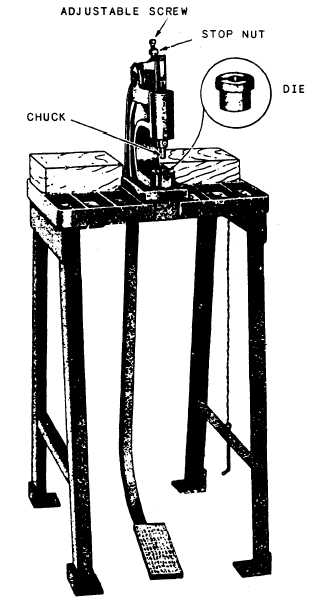effective job can be done by disassembling the
shears and sharpening one shear at a time. The
bottom shear has a more blunt angle than the
upper, so exercise care in the cutback or angle of
sharpening. Also in sharpening, start at the point
or toe of the shear and move toward the heel of
the shear. This drives the heat, generated in
grinding, to the heel of the shear where there is
more metal to radiate the heat. To grind toward
the toe or point drives the heat to the lesser metal,
and it can result in burning the metal and drawing
the temper out.
After grinding the shear,
reassemble it loosely at first so that, on the first
closing, the wire edge resulting from the grinding
is removed.
Another type of shears you will use is known
as pinking shears. This tool is used for cutting a
series of Vs along fabric edges to prevent fraying.
If pinking shears become dull, they should be
returned to the manufacturer for sharpening.
Remember, always keep the shears sharp.
Don’t drop your shears, as this springs the blades
and reduces their cutting ability. DON’T use them
to puncture metal objects or to pry things open.
DON’T use shears as a knife to remove stitching;
you may injure yourself or damage the stitches
you are cutting. (For this job, use an upholsterer’s
knife or a stitch cutting tool.) When shears are
beyond shop maintenance capabilities, return
them to supply for a replacement.
FOOT-OPERATED GROMMET PRESS
With the foot-operated grommet press, as
shown in figure 10-6, you can install grommets
by mass production. The press itself stores the two
parts of the grommet, leaving your hands free to
position material while your foot applies the
needed pressure. The important parts of this press
are the chuck and die. For each type and size of
grommet, there is a corresponding chuck and die.
The chuck is the upper tool; the die is the lower
tool. Use the adjustment screw, located either at
the top or bottom of the foot-operated press, to
prevent pressure damage to the chuck and die.
When set correctly, this adjustment screw will set
the clearance of the chuck and die to 1/32 inch,
about the thickness of bond typing paper, which
is adequate for most grommets. Some foot-
operated presses have been in service for as many
as 25 years and still require only the replacement
of the chuck and die. The foot press may also be
used in the shop to install glove fasteners.
However, if a portable glove fastener installation
tool is needed, you can use the hand press.
239.371
Figure 10-6.-Foot-operated press.
HAND PRESS
The Durable Fastener hand press, as shown
in figure 10-7, mates the two female portions of
the fastener (socket and button) and the two
female portions (stud and eyelet). You will use
this often as you replace Durable Fasteners on
soundproofing, cushions, or other related items
where a portable installations tool is required.
KNIVES
A knife, because of its familiarity, can be one
of the most abused tools. At its best, a knife has
10-10

